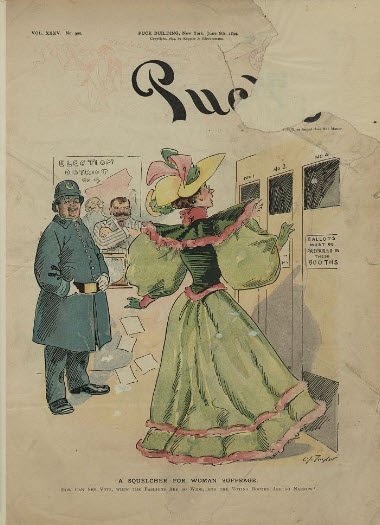The Colonization of the Female Body
March 8, 2022
Since the dawn of time, women have been judged based on their appearance. Placed under a lens, men pick apart a woman’s physical traits and deem her unattractive or attractive. If she is deemed attractive, she will be treated with respect. If deemed unsuitable, she is likely faced with being seen as a waste of time unless she has something else to offer.
Due to this constant barrage of judgment, women aim to do whatever it takes to be seen as “worthy” in the male gaze. During the European Renaissance, women would voluntarily endure the pain of being sucked on by leeches in order to get a pale complexion. In the 18th and 19th centuries, women deformed their ribs and misaligned their spines due to tightly-laced corsets in an effort to have an hourglass figure.
Though now society is arguably more equal for women, these sentiments of patriarchal insecurity have not disappeared.
With the increasingly widespread usage of social media, women are constantly offered the chance to compare themselves with other women. Women who once looked like them until they got plastic surgery. From a nose bridge with a hump to a curved upturned nose, or a small flat chest to double D’s, it’s becoming almost more common to have had some type of plastic surgery than not. While many would argue that it’s done for female empowerment, in a world where the patriarchy constantly brainwashes women and European beauty standards plague the idea of “the perfect woman,” is it more empowering to not give in?
Though plastic surgery has been around for decades longer than today, its frequency and normalization are increasing every year. According to The American Society for Aesthetic Plastic Surgery, women had more than 9.6 million cosmetic procedures performed in 2014, a 429% percent increase from 1997. Female cosmetic procedures made up 90% of the total procedures done.
While there are a variety of reasons as to why there has been such a significant increase, one thing you can pinpoint is the rise of social media and the commodification of celebrities. With social media, it’s almost impossible to scroll through posts without seeing some overly-airbrushed cartoonish photoshopped selfie from some influencer. To many, it looks ridiculous. With alien-like proportions and waists the width of a clarinet, it’s unrealistic. Unobtainable. But it’s normalized. Normalized to the point where young boys expect all women to have a natural wasp-like figure in order to be attractive, and if not- you’re ugly. Then, suddenly even the women who know it’s unrealistic are rushing to do squats in order to be seen as attractive-’worthy’-in the eyes of men.
The sad truth is that men are truly the ones who determine a woman’s self-worth. As English novelist John Berger says in his novel Ways of Seeing, “Men act and women appear. Men look at women. Women watch themselves being looked at. This determines not only most relations between men and women but also the relation of women to themselves. The surveyor of women in herself is male: the surveyed is female. Thus she turns herself into an object of vision: a sight.”
While many women like to believe they are in control of their self-esteem, that itself is a male fantasy. It’s as Margaret Atwood explains in her novel The Robber Bride, saying, “Even pretending you aren’t catering to male fantasies is a male fantasy: pretending you’re unseen, pretending you have a life of your own, that you can wash your feet and comb your hair unconscious of the ever-present watcher peering through the keyhole, peering through the keyhole in your own head, if nowhere else. You are a woman with a man inside watching a woman. You are your own voyeur.”
Women are expected to appear attractive according to undefined standards of beauty that are ever-changing. In the 80s, flat buttocks were all the rage, with women asking their friends in dressing rooms, “Do these jeans make my butt look big?” in fear.
Now, more prominent buttocks are in, and according to the Aesthetic Society, there were over 40,000 buttock augmentations in 2020 alone. The Brazilian butt lift has the highest mortality rate of any cosmetic surgery. Still, the notion that women are willing to risk their lives to appear more attractive is unfortunately not new.
In human life, there are many uncertainties. But growing old and all the bodily effects surrounding this process are guaranteed for every living being. In the past, the different stages of a woman’s life were seen as rights of passage. Becoming a mother and all the effects on a woman’s body was celebrated as a necessary result of bringing life into the world. Lower-hanging breasts showed the results of nourishing your children, and stretch marks were just another reminder of the uniquely-female journey mothers go on. Due to the lower life expectancy in the past, becoming elderly was rare and thus something to be celebrated. The elderly carried and passed on their knowledge, seen as wise storytellers by the younger people around them. As it was common for women to die during childbirth, being an older woman who had birthed children was especially commendable.
Now, while being the most normal thing in the world for both sexes, aging for women is frowned open. Any side effect of aging is seen as just another thing to change. Wrinkles? Try botox. Age spots-you can get that lasered away. While men with grey hair are called “Silver Foxes” and romanticized, various hair dyes to cover up greys are marketed at women.
The issue isn’t that these cosmetic procedures are available but that they are encouraged. Women are constantly being sold products to ‘fix things that do not need fixing. It’s more unnatural to be 70 with no wrinkles than having them, but due to the constant barrage of marketing and comparison, women lose track of what is natural.
Even the most natural part of a woman’s life, pregnancy, is constantly micromanaged by society. A celebrity gives birth, and all magazine headlines say things like “Look at these pictures of how she bounced back to her beach body just one month after giving birth!” or criticisms on a woman’s weight gain or stretch marks after giving birth. Instead of focusing on their children, women are faced with the new anxiety of ‘fixing’ their post-partum bodies to look as if they didn’t just carry a human life inside them for nine months.
Being a woman, it feels like there’s no way to win. We are expected to be completely hairless except for their head, with no pores and no flaws. Basically, women are expected to look like something they aren’t. Something they naturally cannot be. Women are playing a game that’s rigged by men so that the winners will always be men. They control the narrative and have throughout history.
While women were once seen as goddesses due to their ability to carry life, organized religion helped nurture the patriarchy. From Eve consuming the forbidden fruit to Mary Magdalene’s controversial misrepresentation in the Bible, through religion, the idea of male superiority was pushed. The most critical roles in the Christian religion were only held by men, making men seem as if they were closer to God than women were. Women were pitted against each other throughout history. This dynamic is shown during the Salem Witch trials, where women were targeted for perceived societal ills and were infected with paranoia to weaken them. Women were separated, seeing each other as the enemy.
Nowadays, the ways the patriarchy forces women to be weaker are still ever-present. They are ingrained into our society in so many ways and normalized by everyone. By resisting the urge to conform for the purpose of pleasing men, you fight against these ideals that we are so used to. By stepping back and doing things for yourself, not for a man’s approval, you un-brainwash yourself.
It’s time for women to begin analyzing the deeper reasons why we do things. For once, let’s romanticize the things that make us us and stop chasing an idealized version of ourselves.




























